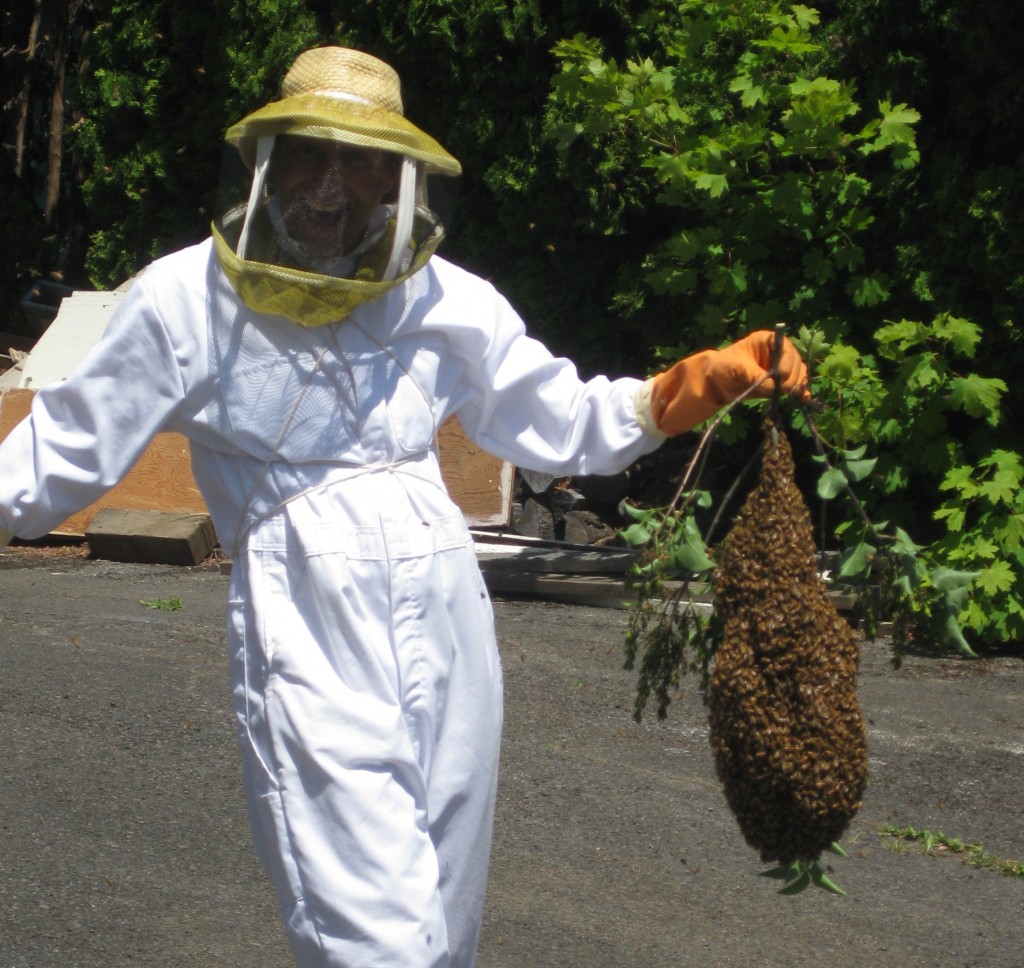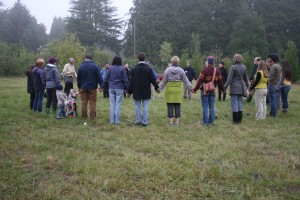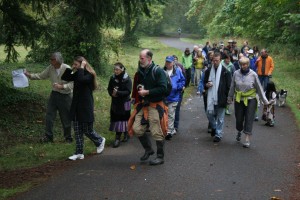 When a honeybee colony’s population expands beyond the bounds of a hive, it will swarm, and in one reproductive act, depart with the original queen and 40,000 or so workers, leaving behind approximately the same amount of workers and soon-to-be hatched queens, one of which will mother the left-behind colony. When a swarm commences, the thrum of thousands of golden, honey-engorged bee bodies fills the air- as well as the heart of one who witness it- with anticipatory glee and a tinge of fearful unknowing. A great cloud of whizzing bees rises up and away from the hive entrance and emits a sweet neroli-like perfume, which identifies the group outside the safe confines of the hive, and sets about to find a tree branch or a fence post to cluster and settle upon. From this vantage the workers will scout out viable locations for a new home. What happens next is instructive to our human family, for if we are to continue to exist (and dare I say thrive) on this planet, must find ways of living together that are based on real needs, democratic processes free of lies, with an openness to the magic of possibility.
When a honeybee colony’s population expands beyond the bounds of a hive, it will swarm, and in one reproductive act, depart with the original queen and 40,000 or so workers, leaving behind approximately the same amount of workers and soon-to-be hatched queens, one of which will mother the left-behind colony. When a swarm commences, the thrum of thousands of golden, honey-engorged bee bodies fills the air- as well as the heart of one who witness it- with anticipatory glee and a tinge of fearful unknowing. A great cloud of whizzing bees rises up and away from the hive entrance and emits a sweet neroli-like perfume, which identifies the group outside the safe confines of the hive, and sets about to find a tree branch or a fence post to cluster and settle upon. From this vantage the workers will scout out viable locations for a new home. What happens next is instructive to our human family, for if we are to continue to exist (and dare I say thrive) on this planet, must find ways of living together that are based on real needs, democratic processes free of lies, with an openness to the magic of possibility.
The bees employ primarily one ancient tool to meet their ends: Inspiration. One by one the scout bees leave the warmth and relative safety of the cluster to search nearby tree cavities, chimney flues or house walls (to name a few) and return to the cluster to report, in the form of a dance, their findings. It is the inspiration of the dance that leads the other sisters to examine a particular location. There is an ebb and flow in the excitement over a particular site selection. Several ‘options’ will be offered at once, and many different dances danced. Eventually, the less desirable choices stop being danced, and the group reaches a consensus over a particular site. Once a significant number of bees is dancing the same dance, they take flight once more, and take up residence in their perfect new home.
 I could see this process, much like the way of the bees’, begin to take shape and was duly inspired by architect Charles Durret’s introductory presentation last weekend to the Oakleigh Meadow CoHousing group, which is seeking to build a housing development on the Willamette River in Eugene, Oregon. He described a process by which a self-selecting group of people come together to build a housing development that suits their needs for community and community dinners, privacy, green living, child rearing, aging, all on a beautiful riverside setting. The group decides everything: Square footage, affordability, setting, distance between buildings, access, etc.. Each member becomes an investor and builder. Chuck and his wife Katie McCamant have facilitated fifty such developments in the U.S.. “I’m amazed at how quickly decisions are made. One person has a good idea, another person a better one. Eventually the group arrives at a third; an even better solution.” Chuck went on to describe how empowered CoHousing groups become, literally bastions of change in their surrounding communities as a direct result of their decision-making capacities.
I could see this process, much like the way of the bees’, begin to take shape and was duly inspired by architect Charles Durret’s introductory presentation last weekend to the Oakleigh Meadow CoHousing group, which is seeking to build a housing development on the Willamette River in Eugene, Oregon. He described a process by which a self-selecting group of people come together to build a housing development that suits their needs for community and community dinners, privacy, green living, child rearing, aging, all on a beautiful riverside setting. The group decides everything: Square footage, affordability, setting, distance between buildings, access, etc.. Each member becomes an investor and builder. Chuck and his wife Katie McCamant have facilitated fifty such developments in the U.S.. “I’m amazed at how quickly decisions are made. One person has a good idea, another person a better one. Eventually the group arrives at a third; an even better solution.” Chuck went on to describe how empowered CoHousing groups become, literally bastions of change in their surrounding communities as a direct result of their decision-making capacities.
At the center of this human swarm is not a queen, but a couple- Joan Connolly and David Adee and their daughter Corinna, long-time residents of the River Road neighborhood who purchased the rare riverfront property two years ago, seeing it as an opportunity to make a community space. “Buying this property was in itself a community experience. My sister in Hilo, Hawaii and my mom were a big part of making this happen” said David, a local music teacher. Joan, a longtime landscape designer and contractor in the Eugene area, was a key player in the design and implementation of nearby Razor Park, a native Oak Savanna planting and dog park a little ways up the river. Both Joan and David feel there is an element of fate in the selection of this property, having been both keepers of community and the river along with their neighbors on River Road, and feel they have been holding the land in wait for the opportunities CoHousing affords.
 Following the architect’s introductory presentation on Saturday, was a site walk with all interested parties Sunday morning. Thirty-plus people arrived from all corners of the riverside meadow at the early hour of eight am, to sip coffee and enjoy bagels as Chuck pointed out landscape features and answered questions from the group. A sign-up sheet for the next phase of the project, the ‘Getting it Built’ workshop slated for Dec. 3rd and 4th, by the end of the day had 17 names. The group’s ultimate goal is 30, and is still welcoming participants. The workshop centers on affordability, development and build-out costs.
Following the architect’s introductory presentation on Saturday, was a site walk with all interested parties Sunday morning. Thirty-plus people arrived from all corners of the riverside meadow at the early hour of eight am, to sip coffee and enjoy bagels as Chuck pointed out landscape features and answered questions from the group. A sign-up sheet for the next phase of the project, the ‘Getting it Built’ workshop slated for Dec. 3rd and 4th, by the end of the day had 17 names. The group’s ultimate goal is 30, and is still welcoming participants. The workshop centers on affordability, development and build-out costs.
An inspired buzz was generated from the weekend which lingered, along with the group, until mid-day. One woman excitedly said, “You know, I like what Chuck said about how we are in denial about aging. I live alone, my house is paid for…but still- there’s something missing. I like how he describes the group-decision-making process, and I would really like to live closer to people.” Another piped up, “Its interesting how he describes modern development as looking backwards, to maximizing square footage and having a car be the forefront of the house as a garage, instead of looking forward to the future of more efficient houses and fewer cars.” A man I talked to wasn’t convinced yet. “I just bought my house, and put a bunch of money into it. I’m not sure how I could do this.” Interestingly though, he was there to see what was going on. Something about it drew him there to the southern end of the meadow, I could see the sparkle in his eyes.
CoHousing is magic; inspirational. Based on real needs and invitational. Democratic and relational. In short, CoHousing is for the bees. Blessings on the Oakleigh Meadow CoHousing group whoever you may bee; may you make the perfect home.